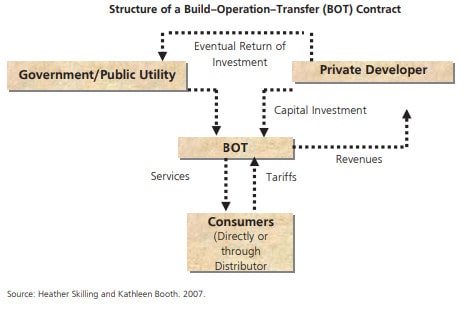A build-operate-transfer (BOT) contract is a type of financing model used for large projects, usually infrastructure projects developed through public-private partnerships.
The BOT scheme refers to a public entity, such as a local government, giving an initial concession to a private firm to build and operate the project in question. Control of the project is returned to the public entity after a specific period of time, typically two or three decades.
What is a Build a Build-Operate-Transfer Contract?
A Build-Operate-Transfer (BOT) Agreement is a contract under which an investor agrees to build, finance the construction of, and operate and maintain a specific infrastructure asset (e.g., an airport, port, power plant, water supply system, etc.) for a set period of time before transferring the infrastructure asset to the government.
The duration of such a contract is typically long enough for the investor to recoup the investment costs of constructing the infrastructure by charging a tariff or user fee while the infrastructure is operational.
How Build-Operate-Transfer Contracts Work?
Under a build-operate-transfer (BOT) agreement, an entity—usually a local government—grants a concession to a private firm to finance, build and operate a mega project. The private company operates the project for a period of time (perhaps 20 or 30 years) with the goal of recouping its investment, then transfers control of the project to the government.
BOT projects are typically large-scale, greenfield infrastructure projects that would otherwise be financed, built and operated solely by the government. Examples include a highway project, a wastewater treatment facility project, and a power plant project.
In general, BOT contractors are special-purpose companies formed specifically for a given project. During the project period—when the contractor is operating the project it has built—revenues are typically generated by a single source, an offtake purchaser. This may be a government or state-owned enterprise.
Power purchase agreements, in which a government utility serves as the offtaker and purchases electricity from a privately owned facility, are an example of this type of arrangement. A traditional concession would allow the company to sell directly to consumers, bypassing the government. BOT contracts also specify minimum prices that the offtaker must pay.
Government involvement in a BOT Project
In a BOT concession, the concessionaire may be required to establish a special purpose vehicle (SPV) to implement and operate the project. The SPV may be established as a joint venture company with equity participation from multiple private sectors and public sector parties.
In addition to equity participation, the government can provide capital grants or other financial incentives to a BOT project. However, it is quite common for the government to have no equity participation in a BOT project firm.
Potential Strengths of BOT Contracts
BOTs have been commonly used to attract private financing for infrastructure development or renovation. Since there is usually only one customer, the government, BOT agreements tend to reduce the commercial risk for the private party. The private partner, on the other hand, must be confident that the purchasing agreement will be honored
Potential Weaknesses of BOT Contracts
Since BOTs have a project-specific application, they can be a good vehicle for a specific investment while having less of an effect on overall system performance. It can be difficult to link increases in output brought on by a BOT with corresponding increases in demand. While the private sector’s experience can reduce initial capital construction costs, private debt can be an expensive substitute for public financing where a take–or–pay agreement is in effect.
Variations on the BOT
There are many variations on the basic BOT model. During the project period, the contractor owns the project under build-own-operate-transfer (BOOT) contracts. Under build-lease-transfer (BLT) contracts, the government leases the project from the contractor and takes over operation during the project period. In other cases, the contractor will both design and build the project. A design-build-operate-transfer (DBOT) contract is one example.
Bottom Line
- In a BOT project, the public sector grantor grants a private firm the right to develop and operate a facility or system in what would normally be a public sector project for a specified period (the “Project Period”).
- BOT project is the typical structure for project finance. As BOT relates to new build, there is no revenue stream from the outset. Therefore, lenders are anxious to ensure that project assets are ring-fenced within the operating project company and that all risks associated with the project are assumed and passed on to the appropriate actor. The operator is also prohibited from carrying out other activities. Therefore, the operator is usually a special purpose vehicle.
- The revenues generated during the operation phase would be used to pay for operating costs, maintenance, debt principal repayment (which makes up a large portion of development and construction costs), financing costs (including interest and fees), and a return to the special purpose company’s shareholders.
See Also
Types of Public-Private Partnership Contracts
Different Types of Contracts










